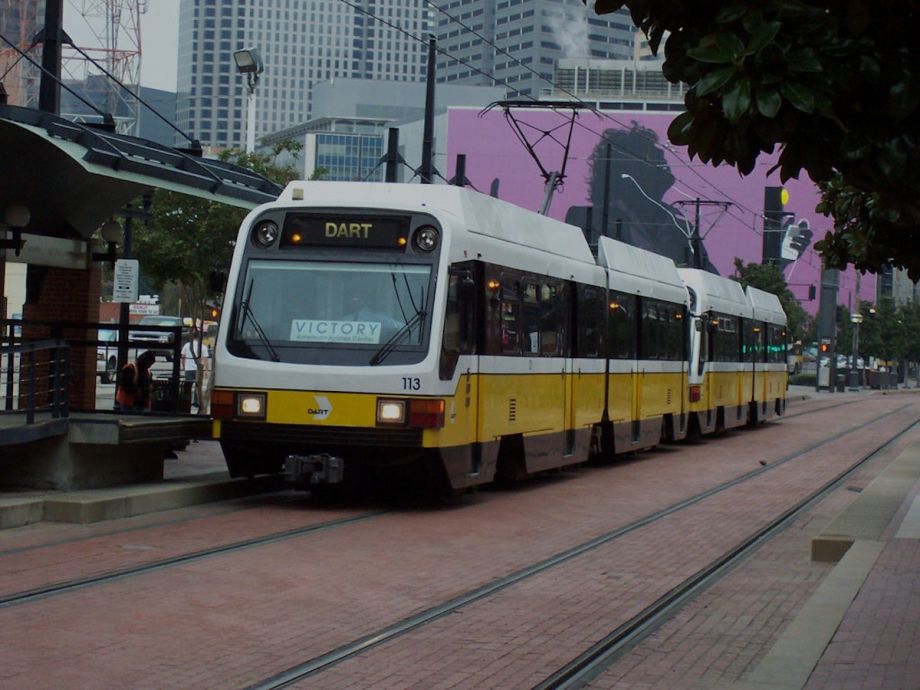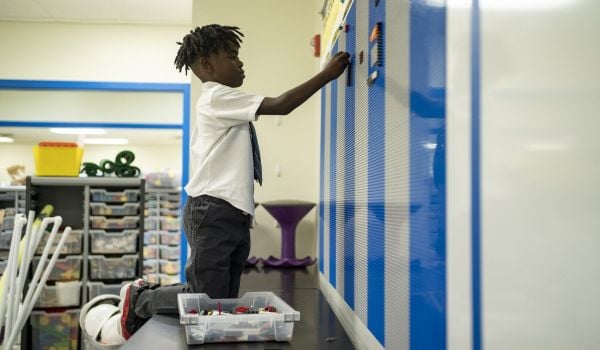A photo of a construction site spilling onto a downtown sidewalk. Another of a car parked on the sidewalk. Prickly cacti blocking access to a crosswalk button. This is all evidence, according to D Magazine, that Dallas “hates pedestrians.” The city’s Department of Transportation, established in 2018, wants to change that perception.
From modern Dallas’ start in the early 1900s, the region largely focused on new development, sprawl and roadways to connect it all. Transportation policy has long been guided by powerful Texas state authorities that invested heavily in car-centric planning. Before 2018, according to Jay Blazek Crossley, executive director of Farm & City, local transit matters in Dallas fell to the public works agency, which has “been just focused on building more roads.” (Farm & City is a nonprofit that promotes sustainable urban and rural living across Texas.)
The young Dallas DOT has taken meaningful steps toward a more holistic vision for city transit and mobility. Most crucially, the agency now serves as a tool to push back against large-scale highway planning.
“We’ve put a greater focus on public input,” says Michael Rogers, the city’s first transportation director. “We’re trying to deliver projects and programs that you hear from the public that they want.”
A shift from a car-centric culture has been percolating in Dallas for the past few years. “In 2007, the idea that it is not good to build major highways in the heart of the city was not considered a powerful argument at the time,” former Council Member Angela Hunt told D Magazine in 2015. “I think we are smarter about transportation. We have a different vision.”
Some of Dallas DOT’s work so far has been foundational. The department drew inspiration from other city agencies, including public works, sustainable development, and the police and planning departments. “We’re developing a sole mission and vision for the department, and looking at how to make it more cohesive,” Rogers says.
He hopes to bring a cohesive approach to urban planning projects involving transit too. “Mobility and transportation has an impact on economic development, housing and housing affordability,” he says. “Our goal is to not do projects in silos but bring others to the table.” Rogers points to a proposed high-speed rail route from Dallas to Houston, and an ongoing study of a “multimodal transportation center” that would be adjacent to the line’s downtown station and connect multiple modes of transit.
The DOT is fully embracing technology. Rogers formed a data analytics team and facilitated the arrival of electric scooter companies. Aerial taxis and autonomous vehicles are on the drawing board in the vision for the downtown transit center.
Other projects have been more modest but important for pedestrian safety. Prior to the DOT forming, the city had no way to determine where school crossing guards should monitor students. The DOT spent 2018 establishing criteria and reviewing intersections near schools to improve that decision-making process.
Perhaps the most significant statement from the agency was concerning the Texas Department of Transportation’s years-in-the-making plan to redo Interstate 30 East, which cuts directly through the city. In January, Rogers said he was shocked to see the state’s proposal to widen the highway and create more barriers between downtown and surrounding neighborhoods.
He pushed back, offering his own “guiding principles” for the redesign. They included better connections for cyclists and pedestrians, no highway expansion in height or width, and bringing the elevated portion of the road below grade to reconnect neighborhoods that have been torn apart by infrastructure development.
Dallas City Council Member Philip Kingston called the pushback “radical,” and said that the “city staff has never taken a lead on shaping a proposed TxDOT project.” He encouraged the city to be bolder and demand the state make I-30 narrower and remove access roads.
The $1.3 billion redo, one of the city’s biggest transportation priorities, ultimately has the potential to reconnect South Dallas and downtown. A long engineering and public input process between the city and state is still to come.
In the meantime, Rogers hired a consultant to help outline a strategic mobility plan, with the idea of applying transit and mobility principals to the city at large. “It’s not another study. It’s really the implementation arm of many of the major plans,” he says. “It’s the playbook the department and staff will need to follow.”
Challenges remain. Twenty-six percent of Dallas’ population is transit dependent, according to a study by the Journal of Transport and Land Use, but there are areas, like North Dallas, that are considered to be complete transit deserts. A big criticism of Dallas Area Rapid Transit’s sprawling rail system: While the largest in the country, it’s inefficient and doesn’t effectively serve many dense neighborhoods.
Dallas DOT is establishing its agenda in Texas and listening to city residents just as transit is likely to be a hot topic in Dallas’ 2019 mayoral race. There’s an ambitious proposal under discussion to demolish I-345 and replace it with a boulevard.
“We’re seeing a significant shift of how people choose their modes [of transportation] to get around the city,” Rogers says. “We want a world-class city here, and it involves all of them.”

Emily Nonko is a social justice and solutions-oriented reporter based in Brooklyn, New York. She covers a range of topics for Next City, including arts and culture, housing, movement building and transit.
Follow Emily .(JavaScript must be enabled to view this email address)
















